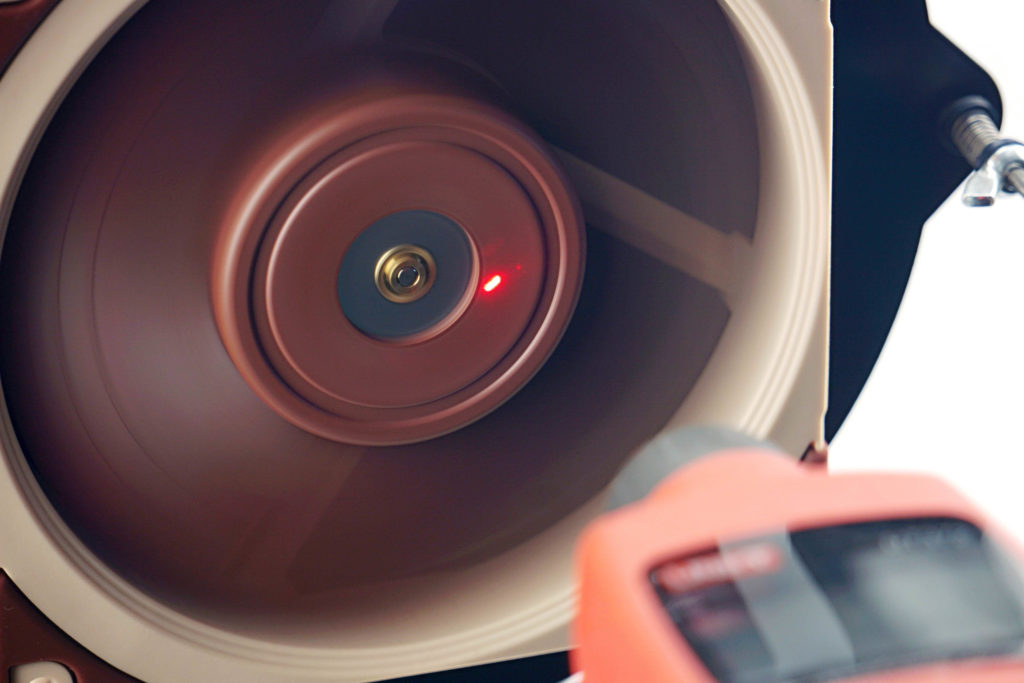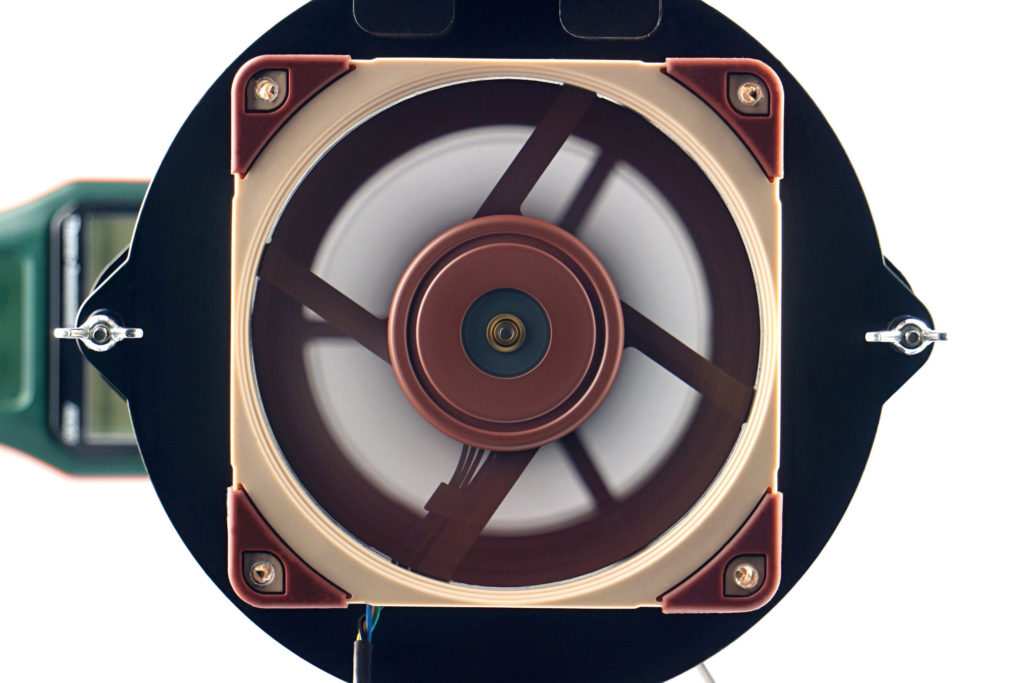Initial warm-up and speed recording
The first Fluctus 120 PWM fans marked a great qualitative progress in SilentiumPC production (now Endorfy). Nevertheless, they had their flaws, which the developers are gradually eliminating and, based on the measurement results, the newer 140 mm Fluctus can be said to be a clear improvement. The Fluctus 140 PWM ARGB stands out nicely from other fans in its price category.
Initial warm-up…
Before we even start measuring anything, we let the fans run “idle” for a few minutes after plugging them in. This is because immediately after a cold start the fans reach different parameters than after a certain amount of short-term operation.
Until the operating temperature of the lubricant is stabilized, a typically lower maximum performance is achieved. This is because at lower temperatures the lubricant is denser, which is associated with higher friction. Therefore, the fans do not reach maximum speed immediately, but only after the first few seconds. Before the first measurements, we therefore leave the fans running for at least 300 seconds at 12 V, or 100 % PWM intensity.
…and speed recording
The speed of the fans is monitored using a laser tachometer, which reads the number of revolutions from a reflective sticker on the rotor. For this purpose, we use the UNI-T UT372 device, which also allows real-time averaging of samples. Thus, we do not record the peak value in the graphs, but the average speed value from a 30-second time period.
However, the speed itself is a relatively unimportant parameter that is often given more attention than is appropriate. This is the case even in many fan or cooler tests, where speed is used to normalize the different modes in which other variables are measured.

However, hyper-focusing on a specific speed is a rather unfortunate decision if only because the fans don’t gain any commonality. At the same speed all other variables are different, there is no intersection. It can be noted that a better normalization would have been by any other variable, whether it be static pressure, flow or noise level, which wins in our case. But more on that in the next chapter.
We only measure the speed so that you can associate a particular parameter (such as the amount of static pressure or some noise level) with something according to which you can adjust the fan yourself. Perhaps for that alone, the information about the achieved speed is useful. As part of the fan analysis, we will also indicate what the fans’ starting and minimum speeds are. Start-up speeds tend to be higher than minimum speeds because more force is required to get the rotor moving than once the fan rotor is spinning, and a minimum power intensity is sought at which the fan does not stall.
- Contents
- Endorfy Fluctus 140 PWM ARGB in detail
- Basis of the methodology, the wind tunnel
- Mounting and vibration measurement
- Initial warm-up and speed recording
- Base 6 equal noise levels…
- ... and sound color (frequency characteristic)
- Static pressure measurement…
- … and airflow
- Everything changes with obstacles
- How we measure power draw and motor power
- Measuring the intensity (and power draw) of lighting
- Results: Speed
- Results: Airlow w/o obstacles
- Results: Airflow through a nylon filter
- Results: Airflow through a plastic filter
- Results: Airflow through a hexagonal grille
- Results: Airflow through a thinner radiator
- Results: Airflow through a thicker radiator
- Results: Static pressure w/o obstacles
- Results: Static pressure through a nylon filter
- Results: Static pressure through a plastic filter
- Results: Static pressure through a hexagonal grille
- Results: Static pressure through a thinner radiator
- Results: Static pressure through a thicker radiator
- Results: Static pressure, efficiency by orientation
- Reality vs. specifications
- Results: Frequency response of sound w/o obstacles
- Results: Frequency response of sound with a dust filter
- Results: Frequency response of sound with a hexagonal grille
- Results: Frequency response of sound with a radiator
- Results: Vibration, in total (3D vector length)
- Results: Vibration, X-axis
- Results: Vibration, Y-axis
- Results: Vibration, Z-axis
- Results: Power draw (and motor power)
- Results: Cooling performance per watt, airflow
- Results: Cooling performance per watt, static pressure
- Airflow per euro
- Static pressure per euro
- Results: Lighting – LED luminance and power draw
- Results: LED to motor power draw ratio
- Evaluation










I have several general questions.
I see how the exhaust airflow pattern is often commended on. By how much does airflow pattern affect cooling performance? For example, assuming two fans have identical airflow rate on a thin radiator. One fan has cylindrical exhaust while the other has conical exhaust. Alternatively, one has a larger fan hub and the other has a smaller one. Or just different blade design in general. Does cooling performance differ, and if so, by how much? How about for case fans? How about on the intake side, does airflow pattern differ there?
The wind tunnel is made free of dust before testing. By how much does dust settled on the wind tunnel/fan blades etc affect airflow and noise? Would a thin layer significantly affect the results?
Great questions. We have had the ones from the first paragraph jotted down for a while and we will deal with them later in specialized tests. We just have to work our way through the other topics. 🙂
As for the effect of fan “dirtiness” on air flow, I wonder how this could be tested. Of course, we keep the wind tunnel as clean as possible (it is even stored in a vacuum chamber) and I don’t think it is a good idea to risk changing the friction or reducing the anemometer speed by some sediments from the tested fan. But we’ll figure something out. For this purpose we could use some of the prototype tunnels that preceded the final one we are using. They have some imperfections, but they should be suitable for this purpose.
I’m in love with these deeply scientific reviews. No other reviewer, ever, anywhere, went to such lengths and details in their reviews, especially about pc fans. Because of them I’m getting now 2x Endrofy Fluctus 140 argb for a top exhaust on case with grill+ dust filter. Having read all other reviews, I do prefer them over Pure Wings 3, they seem to be more efficient and more quiet at similar settings.
Thank you!